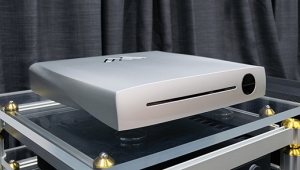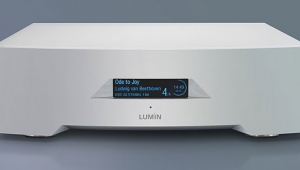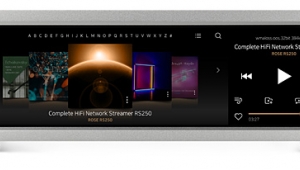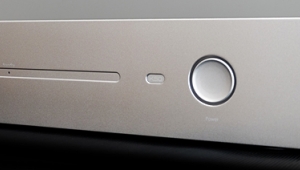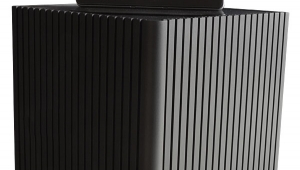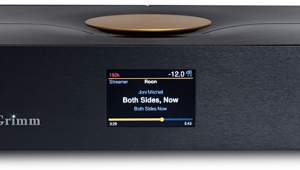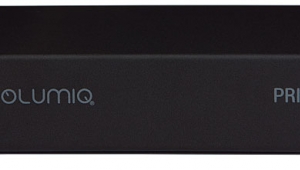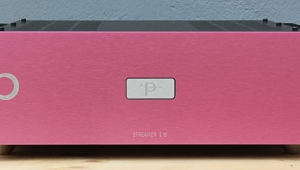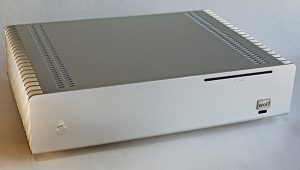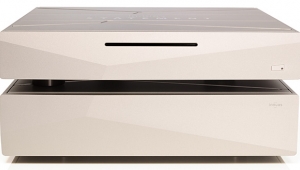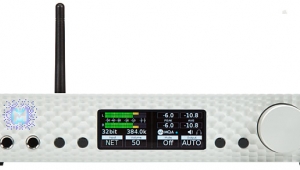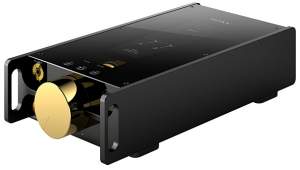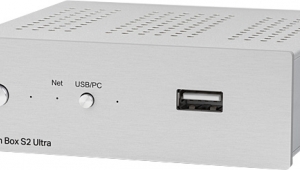| Columns Retired Columns & Blogs |
T+A Music Player Media Streamer Page 2
The analog outputs can be set as either fixed or variable (controlled from the remote), allowing the MP to be connected directly to a power amp or active powered speakers. Because it has built-in digital source switching, the MP and a power amp may be all some folks will need for a modern, all-digital source system, though a volume control on the faceplate would have made such a configuration even better.
Setup
Right out of the box, the MP operates like most CD players: Connect the analog or digital output, pop in a disc, and hit Play. Setting up the Internet-radio or media-server functions takes a bit more time, and T+A has created a handy dedicated website with plenty of pictures and step-by-step instructions to make the job easier.

However, I decided to first take a stab at networking the MP after only a brief glance at the manual. As an extra challenge, I tried setting up the MP first with a wireless connection instead of hardwiring it directly to my network router. After selecting "WLAN Configuration" in the networking menu, the MP locked on to my local WiFi, showing full signal strength. Piece of cake. However, home networking is still a black art in many ways, and just one incorrect setting, a neighbor's wayward open network, or a wireless phone system can bring WiFi to its knees or slow data to a crawl. Therefore, unless you've got solid screamin' WiFi, the LAN/Ethernet port is probably the best way to go if you can get a cable from your router to the hi-fi rack.
The MP's Burr-Brown digital section first upsamples whatever digital source you've chosen to 352.8 or 384kHz, before converting the signal to analog. Two algorithms, selectable via the Audio menu, are available for upsampling: Standard FIR filtering and an Impulse Optimized filter. While Standard FIR sports a more linear frequency and phase response than Impulse Optimized, it also tends to ring a bit more.
You can switch between the two filters with the remote, and while the differences were indeed subtle, I found that, overall, I preferred Impulse Optimized, especially for the extra life and subtle detail it gave voices and midrangey instruments (eg, guitar), and the added nuance in quiet fades. I left the MP in this position for most of my listening and comparing.
Discosaurus
If you didn't know any better, you'd think the MP was a contemporary-looking disc player. Unfortunately, it won't play SACDs or any other hi-rez disc format—it's a CD player only. But what a CD player—its sturdy, nonresonant disc tray, made from laminates of ABS and metal, is powered by Mabuchi motors and quietly slides in and out on two precision stainless-steel rods. When I tapped the drawer with a fingernail, it emitted a dull tick. The entire transport is surrounded in metal and floated on a vibration-suppression system.
About the time the MP arrived, I'd finally tracked down a reasonably priced copy of Mark-Almond's first album, Mark-Almond (1971), remastered for CD (Bodyheat BHR-903). Jon Mark and Johnny Almond had just emerged from John Mayall's shadow to create this often-overlooked gem featuring acoustic guitar, piano, bass, percussion, sax, flute, bass flute (!), and fully landscaped gospel chorus. This is an aged and problematic recording, but the MP always kept everything under control, without hiding any of the analog fuzz that has accumulated on the master tapes over the years. In fact, even though I wish those tape artifacts weren't there, I appreciated the MP's ability to matter-of-factly render them along with the soulful playing.
Which brings me to the character of the MP's sound: cool, calm, and collected. Never was it caught out by a recording it couldn't handle with honesty and control, regardless of pedigree. To get a feel for the other end of the fidelity spectrum, I pulled out Curandero's Aras (CD, Silver Wave SD911), as dynamic and clean an acoustic recording as they come. Flamenco guitars and tabla popped as if they're 6' in front of you, and the MP revealed the music's vivid life and fire with ease.
Later, I inserted Godley & Creme's 1979 masterpiece, Freeze Frame, reissued on a two-for-one CD with Ismism (Edsel MEDCD 745), and cued up "Random Brainwave" and "I Pity Inanimate Objects." These guys, half of the original 10cc, were at their peak as imaginative masters of the analog recording studio (they eventually went digital), and most of their material still sounds tight and innovative next to today's Pro Tools sample-cut-and-paste jobs. The MP laid out all the precise production details in both tracks, cleanly realizing the soft sounds of the acoustic guitars against the periodic edgy sheets of electric guitar and highly processed vocals and textures.
Radio Radio
So much for fossilized formats—it was time to put the Music Player through its networking paces. Though T+A has provided a website to make the job easier (more about that in a minute), I started by using the MP's front-panel menu and remote control to find Internet radio stations and other digital sources. Hit the SCL source button on the remote or front panel and you're presented with a stack of choices on the display. I had an iPod Touch hooked up to the Music Player via the supplied adaptor cable, so in addition to "Internet Radio" and "Favorites," my choices included "iPod."
It took a few minutes to sort out how the menu system works. Using the up and down arrows on the remote or front panel, I selected "Internet Radio," then used the right-arrow button to move out on a menu branch looking for a station. You can begin by sorting the thousands of stations by very broad categories, such as genre or country of origin. Once you start along a branch, the choices keep branching in logical fashion until you finally reach a station. You can then reverse course and head back up the branch to take a different route.
- Log in or register to post comments
